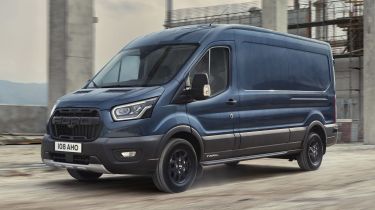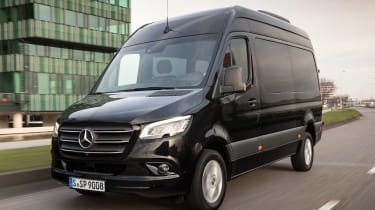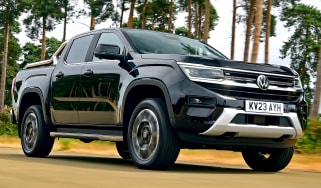Long wheelbase vans: payloads, licences and how to choose one
If you want to carry a lot of cargo in your van, a long wheelbase model could be just the ticket, we explain all...

You’ve decided that you need a new van for your business, and it’s got to be one that can carry all the goods you’re likely to be dealing with so a normal van just won’t cut it. If you’re looking for a long wheelbase van, you’ve come to the right place, this guide with everything you need to know about this breed of vans with extra carrying capacity.
Let’s start with the different types of long wheelbase van and how to choose one. Each of the main sectors in the van market has options with differing wheelbases, which mean there’s a massive amount of choice in the market when it comes to carrying different loads.
Firstly there’s the small purpose-built van - examples include the Citroen Berlingo and Ford Transit Connect. These models have short and long wheelbase options, as well as the usual high roof or crew cab versions as well, and they’re great for city use as they are spacious but compact enough to fit down tight streets.
Then there’s the medium panel van, which has even more space and is also usually available with a choice of wheelbases. Examples here include the Ford Transit Custom and Volkswagen Transporter, which are great all-rounders.
Finally there’s the large panel van class, where you’ll find the Mercedes Sprinter and Volkswagen Crafter among others. These are some of the most versatile work vehicles around and there won’t be much you can’t carry onboard, but they are a bit big for those doing a lot of city trips.

Some people will refer to all vans from the largest panel van class as ‘long wheelbase vans’. It’s understandable as these models are so large in the first place, but as with other vans in other classes, large panel vans are available in short and medium wheelbase forms too. Long-wheelbase vans are really just the longest version of any van where a choice of wheelbase lengths is offered.
If you need a long wheelbase van it may be the case that a regular wheelbase model from a larger class of van is actually what will suit you better. It’s worth noting that larger vans weigh more, which can reduce their payload capacity, while not all long vans actually have a longer wheelbase, some simply have an extended rear overhang to get more cargo on board. There’s more info on payloads and licences below but as a general rule, it’s worth considering a smaller van with a higher payload capacity if you’re carrying heavy items.
Then you’ll want to decide on the engine in your new van, and whether you need a crew cab with an extra row of seating for carrying lots of passengers around. There’s also the roof height to consider, as many vans are available with taller roofs to help with long and tall items - just be aware that taller vans won’t fit in many car parks. Most importantly there’s the price - whichever van you choose, it’s got to be cost-effective for your business.
Long wheelbase van payloads
Rather than listing every single long wheelbase van and their payload capacities, let’s look at how some of our favourite vans compare between versions. This will give you a good idea about how choosing a long wheelbase van affects the payload capacity, all other things being equal.
First up, the small vans. The Citroen Berlingo is available in M and XL forms - there’s no L - and in M form it can carry 1,050kg, yet in XL this drops to 940kg. This can be seen in the Peugeot Rifter, Vauxhall Combo and Toyota Proace City vans as well, since these are all pretty much the same van with different faces and badges.
The Ford Transit Connect is another great small van. A standard wheelbase L1 model (in a base trim) can carry 646kg, while the long wheelbase L2 in the same trim has a payload of 690kg. It’s the opposite to the Citroen above, as the longer model can carry slightly more, but not a lot more.
Moving on to the medium panel vans, a Ford Transit Custom in a low trim level and standard L1 wheelbase has a payload of 1,085kg, while the L2 model can carry 1,005kg. A Volkswagen Transporter SWB can carry 1,029kg, while the LWB model’s payload is 964kg.
Finally let’s look at the large panel vans: a MWB Volkswagen Crafter can carry between 1,076kg and 1,477kg depending on the model, while a LWB version can carry between 1,000kg and 1,326kg.
As you can see the longer-wheelbase models can generally carry less weight than their standard wheelbase equivalents, though there are some exceptions. The general rule is that if you need a longer van to get more load volume, you need to prepare to carry a bit less weight.
Long wheelbase van licences
The other thing you need to consider is that because longer vans are heavier, they edge nearer to the crucial 3.5-tonne weight restriction on a normal driving licence.
The 3.5t limit refers to the van's gross vehicle weight or Maximum Authorised Mass (MAM), it's the weight of the vehicle itself plus the maximum load it can legally carry. This weight category is fixed for each type of vehicle and remains so regardless of how much weight you're actually carrying on board.
You need to be aware of the MAM of the vehicle you're driving as different versions of the same van model can have different MAM ratings and the larger models in a range are more likely to be rated higher than 3.5t. Drivers risk points on their licence and a fine if they drive a van that is rated over the 3.5t threshold and don’t have a C1 licence. There are different rules for those who passed their test before 1 January 1997 - these drivers can drive commercial vehicles up to 7.5 tonnes MAM.
While the vans you can drive legally on your licence are determined by MAM weight categories that are fixed for each model on sale in the UK, there is a separate issue of overloading. If you exceed the MAM, or the gross train weight if you're towing a trailer, of any vehicle by carrying a load that is too heavy, you will be liable for hefty fines.
You can read more about what licences you need for different vans in our explainer article.
Find a car with the experts







